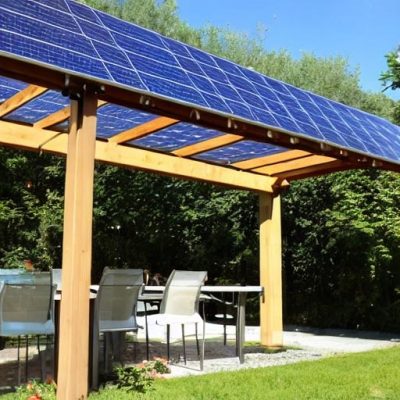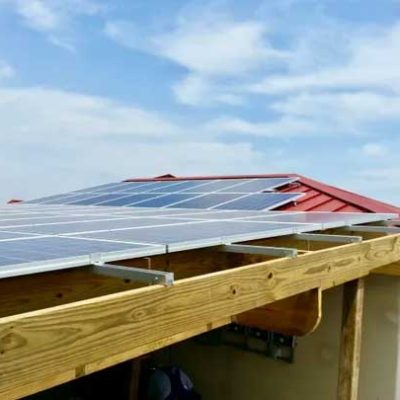Solar pergolas have become increasingly popular, because they give people a way to generate solar power where a rooftop isn’t enough to meet a homeowner’s specific energy needs. Elevating the solar panels on a frame will give you the best of both worlds. Not only will it give you a shaded space that will protect your home from the elements, but it will also give you enough solar energy production to meet your required capacity. It can even be an attractive way to showcase your solar energy investment.
You can find solar pergolas in a variety of custom designs, and they can be made in a number of durable materials (from pressure-treated wood to aluminum). Most of them are designed in a way that will offer the best combination of beauty, cost, and functionality. Some of them even have long warranties that match what is usually provided by solar panel manufacturers (which is 25 years). They’re usually not attached to another structure, but they can be adjacent to your home. So, they can appear to be part of your home. They can also be in an isolated spot to create separate living and entertainment spaces that are close to certain popular areas (such as a pool or lakeside).

When Rooftop Solar Panels May Not Be Suitable
Installing a well-designed and sized solar energy system on a rooftop will usually be the most cost-effective option, but it’s not suitable for every home. Some of the challenges may include the following:
- Excessive shading from trees and other structures, where removing them will cost too much or may not be wanted.
- A roof design that includes pitch or obstacles (such as gables and vents) that make it unsuitable.
- The home electricity needs can’t be met by installing rooftop-mounted solar panels (the available roof area is suitable but won’t support enough solar panels).
- The roof materials are aging, and the homeowner chooses to delay any needed repairs.
- The aesthetics of rooftop solar panels may not be appealing to the homeowner or are restricted by local rules.
Homeowners may also want the advantages that come with solar pergolas.
The Benefits of Solar Pergolas
Some of the advantages of solar pergolas include the following:
- It makes solar energy more accessible — It can be a great option if your roof isn’t suited for a solar panel installation.
- More effective use of yard space — It allows you to use the space for leisure activities while avoiding the problems associated with ground-mounted solar panels that take up too much outdoor space.
- It’s more aesthetically pleasing — It will give you a solar panel solution that will be more pleasing to the eye than a rooftop installation.
- Extended energy generation — It’s a viable option if you already have solar panels installed but want to increase the amount of electricity being produced.
- It will maintain the usability of your yard — You can preserve a space for walking in the yard even after you have installed solar panels.
Be sure to speak to a professional for more information.
The Drawbacks to Solar Panel Pergolas
While solar pergolas have a number of advantages, they do have their drawbacks. Some of them include the following:
- Higher Cost — Solar panel pergolas will cost more to install than standard pergolas.
- Space Constraints — If you’re adding solar panels to an existing pergola, the available space may not be enough to accommodate the number of required solar panels.
- Installation Costs — If your pergola has a flat roof, it will cost more to install them at the proper angle.
The output of solar panel pergolas can also be affected by shadows, because their roofs aren’t as high. This can affect how much energy they produce.


The Cost of Solar Pergolas
The average cost of a solar panel installation will be approximately $.2.42 for each watt of energy that’s being produced. For a 5kW installation, the average cost is about $12,087 before incentives. But the prices can range from $10,274 to $13,900. After the federal tax credit, the average price drops by 30 percent.
The exact cost of installation will depend on the size of the solar panel system. Larger systems will cost more, but you may end up paying less than the average. At the same time, doubling your system size will double the average price of $12,087 in the City of Corpus Christi.
Solar Pergola FAQ
A pergola is an outdoor structure that consists of a set of columns that support a roof of beams and rafters. Solar pergolas have the same basic design but have incorporated photovoltaic cells. This innovative approach blends aesthetics with functionality, which represents the future of sustainable home energy. They can not only serve as an architectural feature but can also be a practical source of renewable energy.
Unlike conventional systems that are installed on rooftops, solar pergolas are free-standing structures that can be placed in a variety of locations around your property. It will give you more flexibility in how they can be placed and designed, which isn’t available with rooftop panels. The adaptability of solar pergolas makes them an appealing choice for homes with a limited amount of roof space or don’t have roofs that are suitable for a solar panel installation.
Solar pergolas work by harnessing sunlight through the use of photovoltaic panels, which are mounted onto the structure itself. This process is referred to as the “photovoltaic effect,” and it is what makes solar energy production possible.
The solar panels serve as the roof of a solar pergola. They’re also positioned in a way that will allow them to capture the most amount of sunlight. They can be adjusted according to their geographical location and the corresponding path to the sun. Doing this will make sure the pergola produces as much electricity as possible.
Solar pergolas come in a variety of styles, sizes, and designs. So, there are options available for any number of aesthetic preferences. But aside from their visual appeal, solar pergolas can serve as functional outdoor living spaces. They can give you a place of shade and comfort as they generate clean and renewable energy. If they’re properly executed and installed, solar pergolas can be an efficient and stylish way to generate sustainable power.
Solar pergolas are eligible for federal tax credits, but they’re subject to certain conditions. It will allow you to deduct a good percentage of the installation costs associated with any renewable energy system from your federal taxes, but the exact percentage can depend on the year of the installation. The tax credit applies to the panels and the total cost of the energy system, which includes any associated equipment and installation costs.
To qualify for the federal tax credit, the pergola must be installed at your primary or secondary residence. It must be used to generate electricity for that residence. You also need to make sure the installation complies with all local building codes and regulations, because it’s a requirement for eligibility. State and local governments may also have additional incentives, rebates, or tax credits. Be sure to speak to a tax professional or renewable energy expert for more information on what you can use.
The energy production of a solar pergola will depend on a number of factors. Some of them include the following:
– The number and efficiency of the panels being used.
– The size and available surface area of the pergola.
– The amount of sunlight the installation receives.
In most situations, solar pergolas can produce a significant amount of the energy requirements for an average household. But the exact figure will vary according to specific circumstances.
You can install solar panels on an existing pergola, but it must be sturdy enough to support them. They must also be placed in a way that will optimize their sun exposure, which is an important part of maximizing their efficiency.
The number of panels you need for a solar pergola will depend on your energy requirements and the size of the pergola itself. A small-to medium-sized pergola can accommodate 4-8 panels. But if you want to meet a specific energy goal, you should take the average output of each panel and your daily energy usage into consideration.
The cost of a solar pergola installation can depend on its size, the materials being used, as well as the number and type of panels being installed. The average cost can be a few thousand dollars. But for more extensive and complicated setups, it can cost tens of thousands of dollars.
If you want to install a solar pergola in your backyard and are looking for one of the best places to help you with the installation, be sure to get in touch with Solar Power Integrator.
